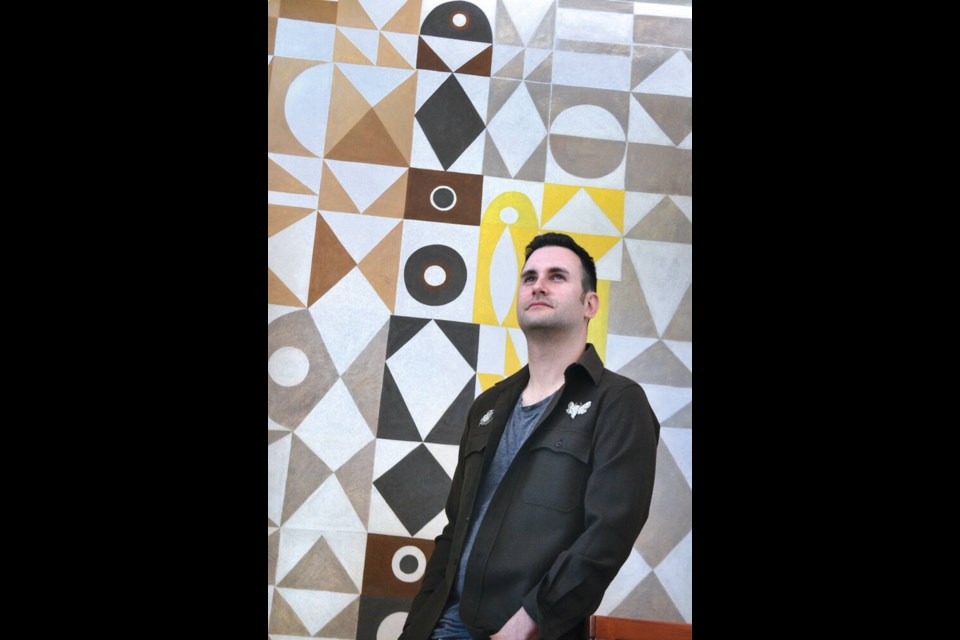Painstaking work to restore some unique murals at the Binning House – one of the province’s most architecturally significant homes – has been recognized with an award by Heritage B.C.
With its floor-to-ceiling windows, flat roof, large overhang and construction from local materials, artist and architect B.C. Binning’s 1941 home is considered to be one of the earliest examples of West Coast Modernism. The West Coast Modern movement sought to make buildings fit in with their environments rather than dominate them, breaking down the barriers between nature and living space. The principles and esthetic continue to influence design today.
Binning adorned his home’s exterior entrance, interior hallway and his studio with his own geometric murals. But, over the decades, the paintings had become damaged and cracked, caked in grime and mould, or covered over completely.
Art conservation
In 2020, Binning House owner Jesse Saniuk sought Cheryle Harrison to restore the murals to how they’d have looked when Binning put his brushes down. More than being a restorationist, Harrison is conservator – an internationally accredited, post-graduate discipline that must adhere to museum standards in their work.
While living in the house, Harrison used a scalpel to carefully remove the modern layers of paint. She hired master plasterer Lloyd Cutter to repair structural damages in the surfaces and worked with experts to match the exact hue and chemistry of Binning’s chosen paints. All told, it was about 300 hours of work.
“Conservation is a step-by step process,” she said. “It’s the history and understanding the artist and their technique, but also the environment of where that artwork has been or is.”
At one point, the story goes, a gardener had power washed much of the exterior mural off. Famed B.C. artist Gordon Smith came in to repaint it. He kept the original composition but didn’t use Binning’s exact colours.
“He was a colourist [interested] in how colours reacted next to each other… So I went through a very laborious process of matching those colours and making sure that it was possible to use them again,” she said. “Although Gordon Smith is a wonderful, recognized artist, this was Binning’s original work and his home so that continuity had to be made.”
One of the murals, in what was once Binning’s studio, had been all but lost, completely covered over with grass-like wallpaper and layers of paint. Saniuk only had reason to suspect it was there because he had seen it in archival photos.
Harrison had to run tests to find out if it would even be possible to remove the outer wallpaper and paint without damaging the very delicate mural underneath.
“It was unbelievable,” Saniuk said. “It felt like a scavenger hunt, almost.”
The result is a rediscovered piece by one of B.C.’s most celebrated artists.
“We were exuberant,” Harrison said. “Because whenever you bring something back, it’s a passage in time but it’s also the fact that people can have more context of what this house was like.”
Saniuk, who is also an art collector, said living in Binning’s home and with his murals has made the artist, who died in the 1970s, less of an enigma, and he continues to appreciate the subtleties in Binning’s work.
“They sort of just bring like a little smile to your face once in a while and when you notice it again, they actually just continue to surprise you,” he said.
West Coast Modern masterpiece lives on
Restoring the murals wouldn’t have made any sense though if the rest of the 83-year-old house on Mathers Crescent, which was already at risk of rot and dilapidation when Saniuk bought it in 2015, wasn’t seen to.
To keep his home livable and extend its life, Saniuk has paid to have the foundation, roof membrane, plumbing, wiring, windows and doors repaired or restored in keeping with heritage standards.
Before he bought the Binning House, it had gone through a bitter tug of war in the courts. The executors of the Binnings’ estate transferred it to The Land Conservancy of B.C., which had promised to preserve it and make it available for scholarly research. But the non-profit wound up in debt and sought to sell the property to stave off bankruptcy. The B.C. Court of Appeal later ruled the property must be sold with the proceeds going to UBC’s BC Binning Memorial Fellowship.
Heritage advocates feared, if not left in the proper hands, the Binning House would be left to rot beyond repair.
The award from Heritage BC has been a strong vindication, Saniuk said.
“The amount of personal time and money put into this house is not something anybody else was willing to do or would have done, so I think the result speaks for itself and it’s a great achievement,” he said. “It’s not just that the house is not going to fall over. A body that is dedicated to heritage is recognizing that the work has been done the right way.”
Saniuk, who’s made a career in real estate, is currently pursuing a master’s degree in advanced studies in architecture at UBC and writing his thesis, and eventually a book, on the Binning House restoration.
“I’m trying to translate the physical restoration process into an academic setting… and record what is often lost, which is the work of restoration and what’s underneath,” he said. “Layers as a metaphor is very important to me.”
Saniuk and Harrison’s work is also winning praise from the West Coast Modern League, which was founded, in part, to advocate for the protection of the Binning House.
“The mural at the exterior front entrance and the two murals in the interior uniquely exemplify Binning’s melding of art and architecture. A catalyst of the West Coast Modern movement, the Binning House is a legally protected heritage property and a National Historic Site of Canada. We support all preservation and restoration efforts carried out with sensitivity and integrity.”




